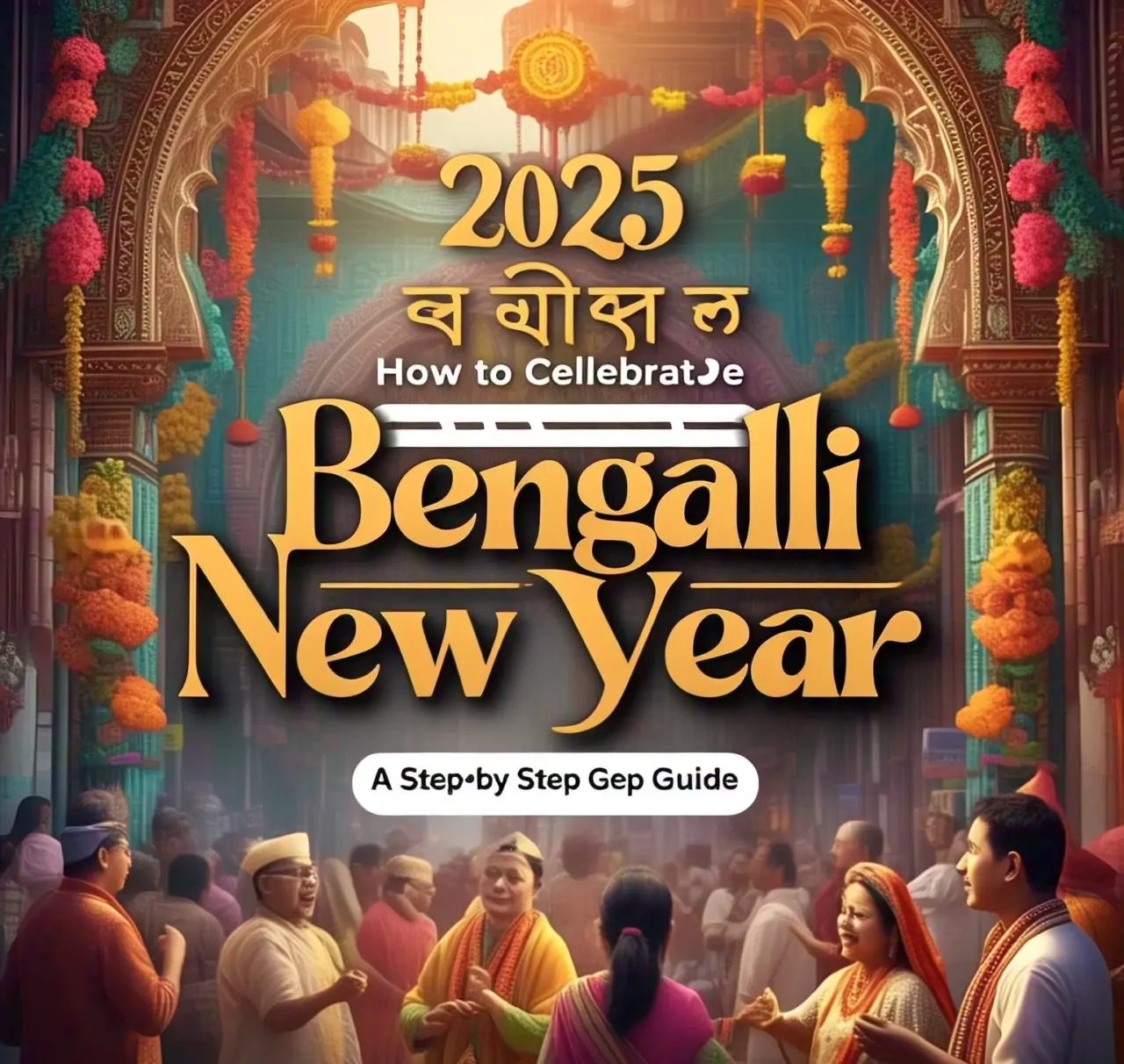Pohela Boishakh, the Bengali New Year, is a vibrant celebration of renewal, culture, and community. Falling on April 14 or 15, 2025 (marking the start of the Bengali year 1432), it’s a time to embrace traditions while looking forward to fresh beginnings. Here’s a step-by-step guide to celebrating in 2025, blending timeless rituals with a contemporary flair.
Step 1: Clean and Refresh Your Space
Tradition: The day before Pohela Boishakh, Bengalis clean their homes to sweep away the old year’s clutter and welcome good fortune.
2025 Twist: Go beyond brooms—declutter digitally too! Organize your phone, back up photos from 2024, and refresh your workspace. Add a sustainable touch by donating old clothes or upcycling decor with Bengali motifs (think nakshi kantha patterns). Light a diya or incense to set a festive vibe.
Step 2: Create Alpana Art
Tradition: Drawing alpana—intricate rice flour or chalk designs—on floors or doorsteps symbolizes prosperity and beauty.
2025 Twist: Experiment with eco-friendly materials like natural dyes (turmeric, beetroot juice) or reusable stencils for a modern look. Snap your creation and share it on social media with #PohelaBoishakh2025—connect with the global Bengali community virtually! For apartments, try a mini alpana on a tray or canvas.
Step 3: Dress in Festive Finery
Tradition: New clothes are a must—women often wear sarees (white with red borders are classic), while men don kurtas or dhoti-panjabi combos.
2025 Twist: Mix tradition with trends—pair a handwoven saree with statement jewelry or a kurta with sneakers. Shop local artisans online for unique pieces, or rent outfits sustainably via fashion apps. Take a family selfie in your festive best and join a virtual “best-dressed” contest!
Step 4: Cook or Enjoy a Bengali Feast
Tradition: Food is central—think panta bhat (fermented rice) with ilish maach (hilsa fish), shorshe bata (mustard paste dishes), and sweets like rosogolla or payesh.
2025 Twist: Host a fusion feast—add a Bengali twist to global dishes (e.g., mustard-spiced pasta) or try a vegan panta bhat with plant-based sides. Order from a local Bengali restaurant if cooking’s not your thing, and live-stream your meal prep with friends for a shared experience.
Step 5: Visit a Temple or Reflect Quietly
Tradition: Many start the day with prayers at temples, seeking blessings for the year ahead. 2025 Twist: If you can’t visit a temple, create a small puja corner at home with flowers and a photo of Goddess Lakshmi or Saraswati. Alternatively, join an online prayer session hosted by Bengali cultural groups—perfect for those abroad or short on time.
Step 6: Exchange “Shubho Noboborsho” Greetings
Tradition: Wishing “Shubho Noboborsho” (Happy New Year) to family and friends strengthens bonds.
2025 Twist: Go beyond calls—send personalized e-cards with Bengali designs or record a fun video greeting. Host a virtual hangout with loved ones worldwide, complete with a toast (maybe with lassi or aam panna) to the new year.
Step 7: Enjoy Cultural Festivities
Tradition: Fairs, processions (like Mangal Shobhajatra), and performances of Rabindrasangeet or folk dances bring communities together.
2025 Twist: Attend local events if possible, or stream live celebrations from Kolkata, Dhaka, or Bengali diaspora hubs. Curate a 2025 playlist—mix Tagore’s classics with new Bengali indie tracks—and dance at home.
Step 8: Set Intentions for 1432
Tradition: Businesses open halkhata (new ledgers), symbolizing a fresh start.
2025 Twist: Adapt this personally—jot down goals for 2025 in a journal (health, learning Bengali, travel plans). Create a vision board with images of Bengali culture (rivers, Durga Puja, haats) to inspire you through the year.
Wrap-Up: Make It Your Own in 2025
Pohela Boishakh 2025 is your chance to honor Bengali heritage while adding a personal, modern spin. Whether you’re in Kolkata, Chittagong, or halfway across the globe, these steps will help you celebrate with joy and meaning. Shubho Noboborsho—may the new year bring you happiness and hope!
Bengali New Year 2025: Quick Answers to Common Questions
Before diving into the celebration, let’s tackle some questions people often ask about Pohela Boishakh:
What is the upcoming Bengali New Year?
The upcoming Bengali New Year in 2025 will mark the start of the Bengali year 1432. It’s celebrated as Pohela Boishakh, typically on April 14 or 15, depending on the lunar calendar and regional traditions.
When did Bengali New Year start?
The Bengali calendar, or Bangabda, traces its origins to the Mughal era. It’s widely attributed to Emperor Akbar, who introduced it in 1584 CE to align tax collection with the harvest season. However, some historians link it to earlier Hindu calendars adapted over time. The modern celebration of Pohela Boishakh as a cultural festival grew stronger in the 19th and 20th centuries.
How to calculate Bengali New Year?
The Bengali year is calculated by subtracting 593 or 594 from the Gregorian year, depending on the date. For 2025:
If Pohela Boishakh falls on April 14, 2025 – 593 = 1432. The exact date shifts slightly due to the solar-lunar Bengali calendar, which starts on the first day of Boishakh (mid-April). Local almanacs (Panjika) confirm the precise day each year.
What is the New Year called in West Bengal?
In West Bengal, it’s called Pohela Boishakh (meaning “First of Boishakh,” the first month). It’s a major cultural event, marked by festivities, food, and music, distinct from the religious focus of some other Indian New Years.


